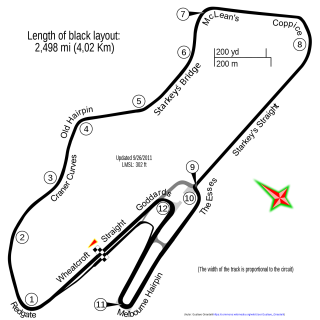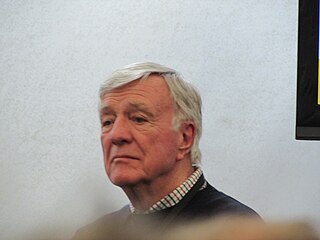
Donington Park is a motorsport circuit located near Castle Donington in Leicestershire, England. The circuit business is now owned by Jonathan Palmer's MotorSport Vision organisation, and the surrounding Donington Park Estate, still owned by the Wheatcroft family, is currently under lease by MotorSport Vision until 2038. It has a capacity of 120,000, and is also the venue of the Download Festival.

Jonathan Charles Palmer is a British businessman and former Formula One racing driver. Before opting for a career in motor racing, Palmer trained as a physician at London's Guy's Hospital. He also worked as a junior physician at Cuckfield and Brighton hospitals.

Emilio de Villota Ruíz is a former racing driver from Spain, born in Madrid. He entered 15 Formula One World Championship Grands Prix between 1976 and 1982, qualifying twice. He entered most Spanish Grand Prix between 1976 and 1982 and became a major force in the short-lived Aurora AFX Formula One Championship for F1 cars, winning the title in 1980.

Michael Christopher Thackwell is a former racing driver from New Zealand, who participated in a number of prominent racing categories, including Formula 1. The sixth youngest driver ever to qualify for a Grand Prix, he participated in five of them, making his first start on 28 September 1980 at the Canadian Grand Prix. He scored no championship points. He had previously attempted unsuccessfully to qualify for the Dutch Grand Prix which was held on 31 August 1980.

William Michael Wilds is a British racing driver from England. He participated in eight Formula One World Championship Grands Prix, debuting on 20 July 1974. He scored no championship points.
Fittipaldi Automotive, sometimes called Copersucar after its first major sponsor, was a Formula One racing team and constructor that competed from 1975 to 1982. It was the only Formula One team to have been based in Brazil. The team was formed during 1974 by racing driver Wilson Fittipaldi and his younger brother, double world champion Emerson, with money from the Brazilian sugar and alcohol cooperative Copersucar. The team raced under a Brazilian licence. Emerson Fittipaldi became a driver for the team in 1976 after leaving McLaren, but was unable to replicate his earlier success with the family-owned team. Future world champion Keke Rosberg took his first podium finish in Formula One with the team.

Desiré Randall Wilson is a former racing driver from South Africa and one of only five women to have competed in Formula One. Born in Brakpan, she entered one Formula One World Championship Grand Prix in 1980 with a non-works RAM Racing-prepared Williams FW07, but failed to qualify. She also raced in the 1981 non-world championship South African Grand Prix in a one off deal with Tyrrell Racing. This race was not part of the 1981 world championship due, in part, to the FISA–FOCA war. She qualified 16th and, after a disastrous start where the car stalled, she moved up through the field in wet conditions; as conditions dried she fell back and damaged the car when it touched a wall while she was letting the race leader through.

Dijon-Prenois is a 3.801 km (2.362 mi) motor racing circuit located in Prenois, near Dijon, France. The undulating track is noted for its fast, sweeping bends.

Formula 5000 was an open wheel, single seater auto-racing formula that ran in different series in various regions around the world from 1968 to 1982. It was originally intended as a low-cost series aimed at open-wheel racing cars that no longer fit into any particular formula. The '5000' denomination comes from the maximum 5.0 litre engine capacity allowed in the cars, although many cars ran with smaller engines. Manufacturers included McLaren, Eagle, March, Lola, Lotus, Elfin, Matich and Chevron.

The International Trophy is a prize awarded annually by the British Racing Drivers' Club to the winner of a motor race held at the Silverstone Circuit, England. For many years it formed the premier non-championship Formula One event in Britain, alongside the Race of Champions at Brands Hatch.
David Price Racing was a British motor racing team, founded by David Price. The team competed in various forms of motorsport from their foundation in 1976 until 2008. The team was sold in April 2009, but continued racing in GP2 and GP2 Asia Series under the name David Price Racing until 2010.
The 1978 British Formula One Championship was the first season of the British Formula One Championship. It commenced on 24 March 1978 and ended on 24 September after twelve races.
The 1979 British Formula One Championship was the second season of the British Formula One Championship. It commenced on 1 April 1979 and ended on 7 October after fifteen races. The Drivers' Championship was won by Englishman Rupert Keegan who drove an Arrows A1 entered by Charles Clowes.
Italian motor manufacturer Alfa Romeo has participated multiple times in Formula One. The brand has competed in motor racing as both a constructor and engine supplier sporadically between 1950 and 1987, and later as a commercial partner since 2015. The company's works drivers won the first two World Drivers' Championships in the pre-war Alfetta: Nino Farina in 1950 and Juan Manuel Fangio in 1951. Following these successes, Alfa Romeo withdrew from Formula One.

The Hesketh 308E is a Formula One racing car model built by the Hesketh Racing team in 1977. The car was designed by Frank Dernie and Nigel Stroud and was the last car built by the Hesketh team before it folded at the end of 1978. The 308E was a relatively conservative design, with an aluminium monocoque chassis built around the common Cosworth DFV engine and Hewland gearbox combination. However, the 308E gained particular notoriety owing to Hesketh's team sponsors in 1977 – Penthouse and Rizla – and the resultant livery which incorporated a large rendering of a scantily clad Penthouse Pet embracing a Rizla packet. During this year, driver Rupert Keegan managed to qualify the car at every race entered although its best finish was only seventh place at the Austrian Grand Prix. For 1978 the team reverted to rather less controversial sponsorship from the Olympus Corporation, although results were less dependable. Following Hesketh's withdrawal from the F1 World Championship the remaining 308Es were run for various competitors in the British Aurora AFX championship.
The 1980 British Formula One Championship was the third season of the British Formula One Championship. It commenced on 4 April 1980 and ended on 5 October after twelve races. The Drivers' Championship was won by the Spaniard Emilio de Villota who drove a Williams FW07 entered by RAM Racing.

The Arrows A1 was the car with which Arrows Grand Prix International competed in the 1978 and 1979 Formula One seasons. It replaced the Arrows FA1, which was banned by the London High Court on 31 July 1978 after a legal protest from the Shadow team on the grounds that it was a carbon-copy of the Shadow DN9. Arrows anticipated that they would lose against Shadow and designed and built the A1 in under 60 days whilst the court case was being heard. Hence Arrows were able to present the Arrows A1 to the press just three days after the court case ended and did not miss any races.

The BRM P207 was a Formula One racing car, designed by Len Terry and constructed by British Racing Motors, which raced in the 1977 Formula One season. It was powered by a 3.0-litre V12 engine, with a claimed output of 488bhp. London-based Swiss watchmakers Rotary Watches provided sponsorship money. The car failed to score any points during the season. The team made a total of nine entries during the season, but only qualified in one instance, at the 1977 Brazilian Grand Prix. Driven by Larry Perkins, the car retired on lap one due to overheating. Its qualifying time was six seconds slower than that of the second-to-last starter. One British journalist in Brazil exclaimed that he was ashamed of being British. The car failed to appear at the season opening Argentine Grand Prix because it was too wide to fit in the hold of the aircraft that was going to transport it to South America.
Lars Eje Elgh is a Swedish racing driver and television reporter. He currently works as an expert commentator for Formula One in Sweden together with Janne Blomqvist. The two have worked together as Formula One commentators for a long time, first for TV4 and then for Viasat Motor when they took over the Formula One broadcasting in Sweden.
The BRM P230 was an open-wheel Formula One racing car, designed and developed by Aubrey Woods, and built by British constructor BRM, for the 1979 Aurora AFX F1 1979 British Formula One Championship, but never raced. It was due to be driven by Neil Bettridge, and like its predecessor was going to be powered by a nearly 500 hp (370 kW) BRM V12 engine, and run on Goodyear tyres. It later became the basis for the unraced BRM Hepworth GB-1 Can-Am car.











